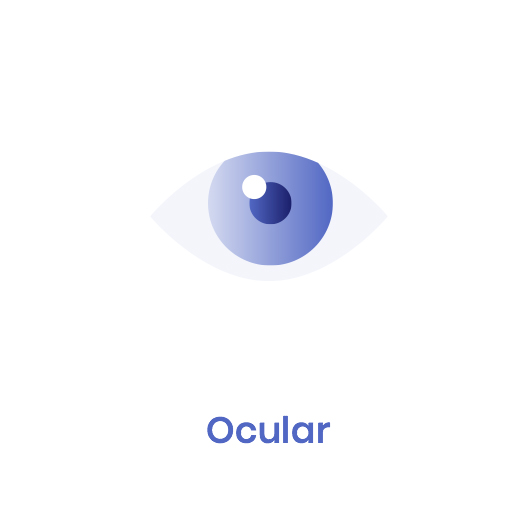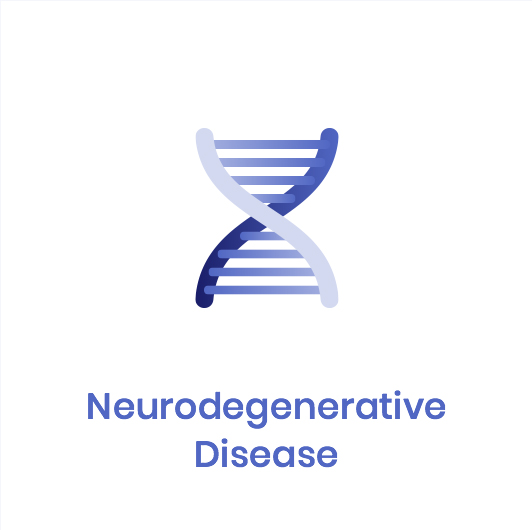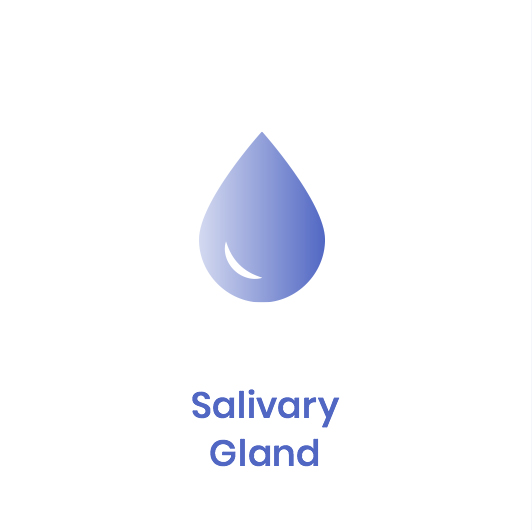Therapeutic Areas
Our research and development efforts are focused on three areas with distinct medical need: ocular, neurodegenerative, and salivary gland diseases. People with these diseases currently have no or limited treatment options, however gene therapy offers potentially curative treatments.
Ocular Diseases
Our ocular portfolio consists of ongoing research and clinical programs for chronic and inherited retinal diseases (IRDs), a group of rare genetic disorders that can cause severe vision loss or impairment. Many IRDs are progressive, meaning that over time, people living with IRDs often experience complete blindness. MeiraGTx is working to develop gene therapies that may slow or stop progression of these diseases.
IRDs are particularly strong candidates for gene therapy treatments due to unique physical makeup of the eye, which offers easy accessibility for treatment administration and monitoring, and allows for treatments to be administered at lower doses and at a single intervention. Learn more about the investigational therapies currently in our pipeline.
X-linked retinitis pigmentosa (XLRP) is a severe form of retinitis pigmentosa, a group of IRDs that that cause serious vision impairment and blindness. Retinitis pigmentosa affects about 1 in 3,500 people, with XLRP accounting for approximately 15% of all retinitis pigmentosa cases.
Visual impairment in XLRP initially manifests with loss of night vision during adolescence, followed by progressive constriction of the visual field in adulthood, and eventual advancement to central vision loss and legal blindness by 30 to 40 years of age. Due to its inheritance pattern, XLRP affects men and women differently, with men more likely to experience severe symptoms. One in 40,000 people in the U.S. are expected to be living with XLRP, and it’s estimated that approximately 20,000 XLRP patients are among the U.S., Japan and EU5.
XLRP is most commonly caused by a defect in the RPGR gene, which encodes a protein called X-linked retinitis pigmentosa GTPase regulator (RPGR) that plays a vital role in the development of the cells that make up the retina, a thin layer of tissue found on the back wall of the eye. Absence of this functional protein results in poorly functioning rod and cone photoreceptors, parts of the eye which are responsible for vision at low and high light levels, as well as seeing color.
RPE65-associated retinal dystrophy is an ultra-rare IRD which impairs vision from birth and results in the degeneration of the entire retina over time. RPE65-associated retinal dystrophy is caused by variants in the RPE65 gene.
Most RPE65-deficient patients experience poor vision in low-light conditions from a young age and suffer from central vision loss that progresses to complete blindness by early adulthood.
One in 125,000 people in the U.S. are expected to be living with RPE65-associated retinal dystrophy.* There are estimated to be approximately 6,000 RPE65-deficient patients in the U.S., Japan and EU5, with almost 30% of those patients under the age of 30 years old. Approximately 50 new cases are diagnosed annually.
RPE65-associated retinal dystrophy is often characterized as a specific subtype of Leber congenital amaurosis (LCA) caused by disease-causing variants in the RPE65 gene (LCA2), or a specific subtype of retinitis pigmentosa caused by disease-causing variants in the RPE65 gene (RP20).
*Based on an estimated prevalence of approximately one in 500,000 people in the U.S. with LCA related to disease-causing variants in the RPE65 gene, and approximately one in 70,000 people in the U.S. with RP due to disease-causing variants in the RPE65 gene.
Achromatopsia (ACHM) is an IRD that specifically prevents cone photoreceptors from functioning properly. As a result, those with ACHM are legally blind from birth and usually suffer from severely reduced visual acuity, a disabling sensitivity to light (also known as photophobia), total color blindness, and involuntary back and forth eye movements (also known as nystagmus).
ACHM occurs in approximately one in 30,000 people in the U.S. and is estimated to impact approximately 24,000 patients in the U.S., EU5, and Japan. To date, mutations in six different genes have been identified as causing ACHM, however the CNGB3 and CNGA3 genes are the two most common of these genes, together accounting for up to 90% of ACHM cases.1
1 Koma´romy, A., Alexander, J., Rowlan, J., Garcia, M., Chiodo, V., Tanaka, J., Acland, G., Hauswirth, W., & Aguirre, G. (2010). Gene therapy rescues cone function in congenital achromatopsia. Human Molecular Genetics, 19(13), 2581–2593. doi: 10.1093/hmg/ddq136
RDH12
RDH12-associated retinal dystrophy, often characterized as a specific subtype of Leber congenital amaurosis or retinitis pigmentosa, is a severe IRD caused by variants in the RDH12 gene. Mutations in the RDH12 gene cause widespread retinal degeneration, resulting in marked central visual loss by 20 years of age. MeiraGTx is investigating delivery of a functional copy of the RDH12 gene to the retina of RDH12-deficient patients.
AIPL1 Compassionate Use
MeiraGTx also has a gene therapy product candidate that was manufactured and released for compassionate use under a specials license in the U.K. to treat patients with Leber congenital amaurosis 4, or LCA4, caused by mutations in AIPL1 gene.
Age-related Macular Degeneration
In addition to our IRD portfolio, we are also progressing preclinical programs that apply novel approaches to both wet and dry age-related macular degeneration (AMD).
AMD is a chronic eye condition that causes gradual decline of central vision. It is the leading cause of vision loss in individuals over 50 years of age U.S. and affects approximately 6.2 million people globally. Although AMD does not usually lead to complete blindness because peripheral vision is generally maintained, losing central vision has a critical impact on visual acuity and central retinal function and can significantly impact a person’s independence and quality of life.
AMD is a complex disease attributed to several different causes, wet and dry AMD are two late forms of the disease. Wet AMD is defined by the growth and invasion of immature blood vessels into the retina. Leakage from these fragile blood vessels causes build-up of blood and fluid under the retina and results in long term scarring and damage. Dry AMD is characterized by the progressive, irreversible loss of many of the cell types and underlying capillaries in the retina, causing a decline in central visual function.
Neurodegenerative Disease
While gene therapies have emerged as promising options for rare, inherited genetic disorders, we believe that opportunity exists for gene therapies to treat broader indications, such as neurological diseases and disorders like Parkinson’s disease, amyotrophic lateral sclerosis, and Alzheimer’s disease.
Parkinson’s disease is a progressive neurodegenerative disorder affecting nearly one million Americans and approximately 10 million people worldwide.
Parkinson’s is caused by degeneration of dopaminergic neurons which affect motor control and function. In addition to cardinal symptoms such as shaking or tremors, bradykinesia (slow movement), and rigidity, dopamine loss also commonly leads to additional non-motor symptoms, including cognitive impairment, mood, and behavioral changes.
Parkinson’s is typically first diagnosed after age 60. Only ~10% of patients experience first symptoms before the age of 50. Approximately 60,000 new cases are diagnosed each year in the U.S. alone.
Current treatments provide symptomatic relief, but none modify the underlying progression of the disease. Around 50% of Parkinson’s patients stop responding adequately to oral dopaminergic therapies within five years of diagnosis, leading to significant deterioration of motor symptoms and a poor quality of life. Deep brain stimulation (DBS) is the established standard of care for patients no longer responding to oral therapies, however, while effective in controlling motor symptom, the treatment is invasive and carries safety concerns.
We believe gene therapy has the potential to be a safer, less burdensome, and superior treatment option than what is currently available to patients. Learn more about our investigational gene therapy AAV-GAD, a novel, one-time treatment that we believe offers a simpler and safer alternative to current standards of care.
Amyotrophic lateral sclerosis (ALS) is a progressive, neurodegenerative disease leading to the loss of motor neurons, which are critical to a person’s ability to move, speak, swallow and ultimately to breathe. Over time, loss of motor neurons gradually leads to paralysis and invariably, death.
Mutations in over 20 genes have been identified that cause the inherited ALS cases.1 While 10 percent of ALS cases are caused by inherited genetic mutations, most ALS occurs sporadically, with no known genetic cause. Rather than targeting a specific genetic defect that defines a small subset of ALS patients, we aim to use gene therapy to target the underlying cell biology driving motor neuron death, potentially enabling us to treat both sporadic and inherited forms of the disease.
1Taylor, J., Brown Jr., R., & Cleveland, D. (2016). Decoding ALS: from genes to mechanism. Nature, 539, (197–206). doi:10.1038/nature20413
With the world population aging, Alzheimer’s disease has emerged as a common and costly disease. Two biological pathways have been identified that are considered causes of Alzheimer’s disease: (i) misprocessing of amyloid precursor protein (APP) caused by genetic defects in APP itself and the APP processing proteins presenilin 1 and 2 and (ii) the movement, or trafficking, of cellular protein which is controlled by a cell component called the endosome.
Over the past decade, evidence has emerged supporting endosomal trafficking dysfunction in neurons as a central process in Alzheimer’s disease. Our Alzheimer’s disease program is directed towards endosomal trafficking as an underlying cell biology of the disease.
Salivary Gland
Rather than replacing a gene that is defective or missing in a monogenic disease, gene therapy can also provide a therapeutic impact by adding a particular new gene function to cells and thereby change cell behavior and function. This is the aim of our salivary gland programs, where our investigational treatments are designed to promote water to flow through otherwise impermeable cells in damaged salivary glands and therefore increase saliva flow into the mouth.
Xerostomia, a chronic and debilitating disorder of the salivary glands in which saliva production is impaired. Xerostomia has a number of different potential causes, including radiation therapy for head and neck cancer. Radiation as a treatment for head and neck cancer can cause irreversible damage to non-diseased tissues located near oral tumors, such as the salivary glands.
The fluid secreting, or acinar cells, of the salivary glands are uniquely sensitive to radiation, resulting in chronically reduced salivary output. Because saliva plays such a critical role in the physiology and protection of upper gastrointestinal tract tissues, patients with chronic radiation-induced xerostomia (RIX) suffer severe long-term complications, including difficulty swallowing, oral discomfort (burning) malnutrition, oral mucositis, changes in taste, increased oral infections and dental cavities.
Worldwide, approximately 650,000 new cases of head and neck cancer are diagnosed each year, with approximately 54,000 cases in the U.S.1 Eighty-five percent of radiation-treated patients reported reduced saliva production, of whom 40% have persistent Grade 2/3 RIX.2 In the U.S., RIX is believed to affect approximately 170,000 patients.3
1Bray F, Ferlay J. Soerjomataram I, et al. Global cancer statistics 2018:GLOBOCAN estimates of incidence and mortality worldwide for 36 cancers in 185 countries. CA Cancer J Clin 2018:68:394
2Jensen S.B., et al. (2010). A systematic review of salivary gland hypofunction and xerostomia induced by cancer therapies: prevalence, severity and impact on quality of life. Support Care Cancer. 18(8):1039-1060.
3Cox J.D., et al. (1995). Toxicity criteria of the Radiation Therapy Oncology Group (RTOG) and the European Organization for Research and Treatment for Cancer (EORTC). Int. J. Radiation Oncology Biol. Phys. 31(5):1341-1346
Sjogren’s syndrome is an autoimmune disease in which the immune system may target the salivary glands, causing chronic inflammation and long-term damage of the glands.
Sjogren’s syndrome is one of the most prevalent autoimmune diseases, believed to affect nearly four million Americans.1 Nine out of ten diagnosed patients are women, however Sjogren’s can be diagnosed in all ages, races and genders.1
Symptoms of Sjogren’s syndrome vary from person to person, however the two most common symptoms are dry mouth and dry eye.2 Other symptoms may include, dental decay, dry or peeling lips, dry or burning throat, or difficulty swallowing, chewing, or speaking.1



